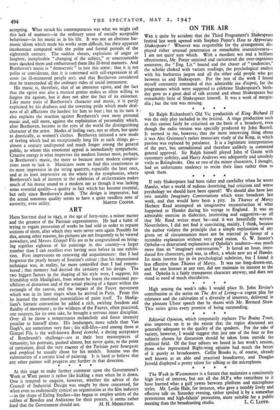ART
HAIM SOUTINE died in 1943, at the age of forty-nine, a minor master and the greatest of the Parisian expressionists. He had a habit of trying to regain possession of works he had sold in order to repaint sections of them, after which they were never seen again. Possibly for this, among other reasons, his pictures are not frequently to be viewed nowadays, and Messrs. Gimpel Fils are to be congratulated on bring- ing together eighteen of his paintings in this country—a larger number than I can recollect ever having seen before in one exhibi- tion. First impressions on renewing old acquaintances: that I had forgotten the pearly beauty of Soutine's colour ; that his impassioned technique was, in reality, far more controlled than I had remem- bered ; that memory had decried the certainty of his design. The two biggest factors in the shaping of his style were, I suppose, his friendship with Modigliani, from whom he learnt the emotional pos- sibilities of distortion and of the actual placing of a figure within the rectangle of the canvas, and the impact of the Fauve movement which was in its later stages when he arrived in Paris. From this he learned the emotional potentialities of paint itself. To Modig- liani's hieratic convention he added a rich, swirling freedom and fluidity of movement ; to the wildness of the Fauves, often practised, one suspects, for its own sake, he brought a nervous inner discipline. Over all he threw a tempestuous melancholy and fierce intensity peculiar to himself alone. His landscapes, more subtle than Van Gogh's, are sometimes very fine ; his still-lifer—and among those at Gimpel Fils is the well-known Boeuf ecorche, a daring acceptance of Rembrandt's challenge—are at their best masterpieces of virtuosity; his portraits, pushed almost, but never quite, to the point of caricature, distil the very essence of the Parisian petit bourgeois and employe he usually chose for his models. Soutine was the culmination of a certain kind of painting. It is hard to believe that any other painter will progress any further in that direction.
* * * * At this stage to make further comment upon the Government's Work or Want poster is rather like kicking a man when he is down. One is tempted to enquire, however, whether the advice of the Council of Industrial Design was sought by those concerned, for when even so endemically cynical an organisation as the film industry —in the shape of Ealing Studios—has begun to employ artists of the calibre of Bawden and Ardizzone for their posters, it seems rather


































 Previous page
Previous page